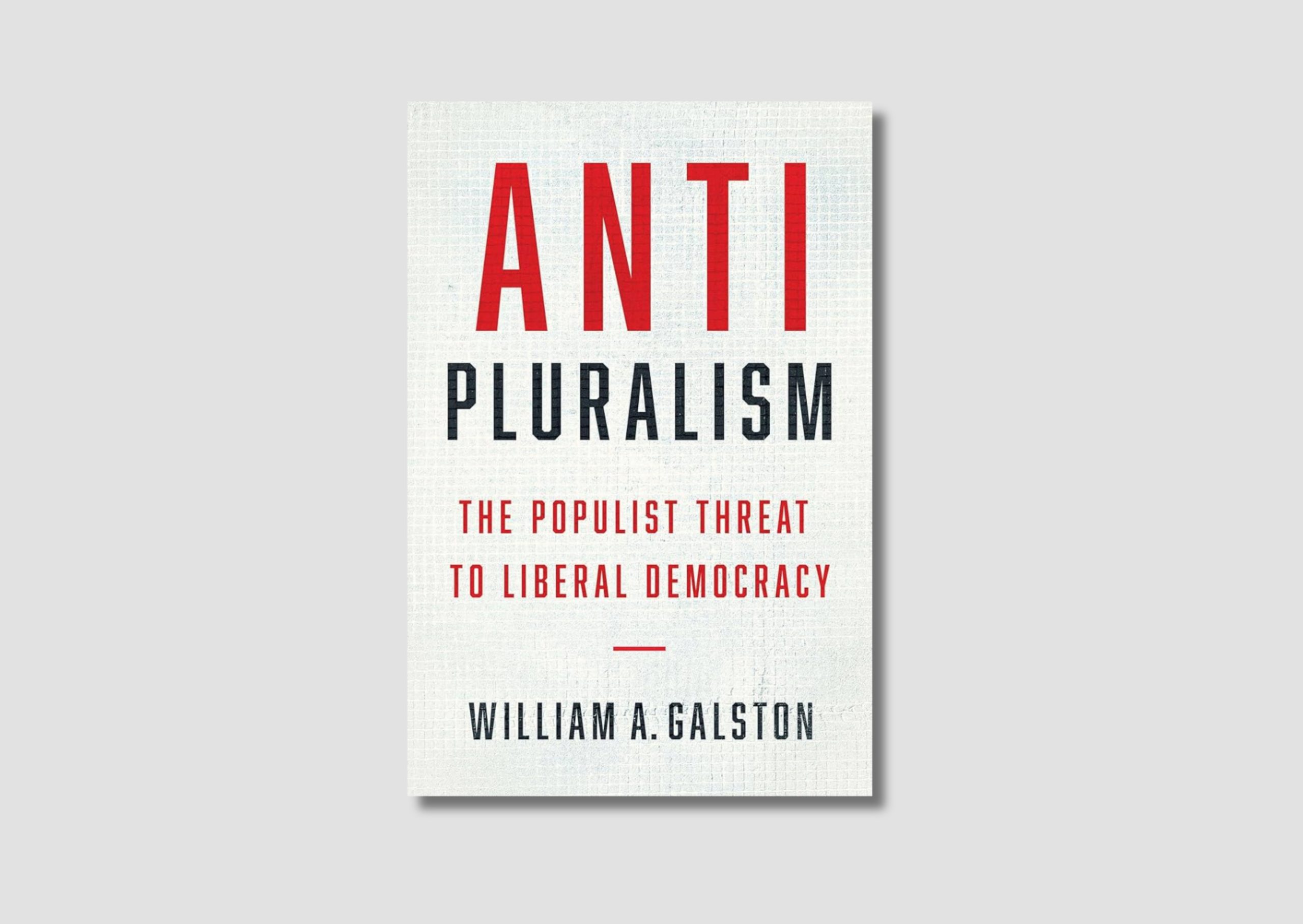At the Crossroads of Liberal Democracy: The Rise of Populism
William A. Galston, Anti-Pluralism: The Populist Threat to Liberal Democracy
By | Aakil Visram,
SEPTEMBER 01, 2024

In an age where populism is surging globally, liberal democracies are grappling with its profound effects. Increasing distrust of institutions, the spread of fake news, and the embrace of strongmen have put democracy in peril. William A. Galston’s book, Anti Pluralism: The Populist Threat to Liberal Democracy, thoroughly examines these populist and anti-pluralist movements within established democracies, shedding light on the rising discontent and antipathy toward traditional liberal norms. While Francis Fukuyama famously argued in The End of History that the spread of liberal democracy marked the endpoint of humanity’s ideological evolution, Galston warns that such optimism may have been premature. He skillfully combines theoretical insights with empirical and historical evidence to demonstrate the vulnerabilities of liberal democracies, exposing how right-wing populists manipulate and weaken liberal ideals in their quest for power. Galston offers a strategic roadmap for those committed to steering Western societies back to prosperity and countering the populist challenge. His introduction also addresses the inherently divisive nature of liberal democracy, which restricts the human tendency for cruelty and aggression, as Augustine described with the term libido dominandi. Overall, Galston’s work serves as both a cautionary tale and a thoughtful examination of the ideological conflicts that threaten the very foundation of liberal democracy.
The book first explores the “crisis of democracy,” rooted in empirical evidence that highlights the global decline of democratic systems. In the first chapter, Galston provides a nuanced examination of several underlying factors contributing to this decline. These factors include severe economic disparities, particularly uneven growth, social challenges like mass immigration, and a growing cultural divide between urban and rural populations. Additionally, Galston highlights the political consequences of persistent gridlock in democratic systems, especially in Western societies post-Berlin Wall. This combination of forces has fuelled public demand for authoritative political figures, paving the way for populist leaders who, according to Galston, have effectively capitalized on this demand.
In the subsequent chapter, Galston delineates four foundational elements essential to the functioning of liberal democracies: the republican principle, democracy itself, constitutionalism, and liberalism, alongside a commitment to market economies. He argues that these pillars are currently under threat from the surge of populism. Aligning with dominant scholarly interpretations, Galston defines populism as a political ideology centred around the dichotomy between a virtuous, unified people and a corrupt elite (Chapter 3). He contends that populism, with its rejection of checks and balances and its antipathy toward pluralist democracy, is fundamentally incompatible with the principles of liberal democracy.
Galston proceeds to offer a historical analysis of the emergence of populist parties in Europe, focusing on countries such as Hungary, Poland, and France (Chapter 4). His analysis suggests that populist voters are united by their dissatisfaction with recent economic trends, their desire to protect Western culture from perceived threats like Islam, their aversion to immigration, and their deep distrust of EU bureaucrats. Given these dynamics, Galston concludes that the antidote to populism in Europe must go beyond purely transnational approaches and incorporate a robust, pluralistic form of nationalism.
Turning his attention to the United States, Galston examines the roots of populist movements within the American context (Chapter 5). He identifies several transformative developments, including the widening economic divide between urban and rural areas and stagnant wages in low-skill jobs. These factors, coupled with pressures from immigration and international trade, have left specific segments of the population feeling alienated and left behind. Galston further argues that political polarization in the U.S. has reached unprecedented levels, particularly within Congress, rendering the government increasingly ineffective. Populist leaders have tapped into this discontent by pledging to “break the rules” to “set things right.” Although Galston acknowledges that American institutions have largely withstood the populist challenge, as evidenced by the Trump presidency, he stresses that the rise of populism serves as a stark reminder that liberal democracy should not be taken for granted.
In the final chapters, Galston outlines a series of political strategies to counter the populist threat to democracy in the United States. He proposes a range of economic policies aimed at stimulating growth and ensuring a more equitable distribution of benefits (Chapter 6). These include pursuing full employment, implementing wage-enhancing measures, increasing capital gains taxes, and expanding broadband access to rural areas. Additionally, he recommends encouraging population growth through state-supported childcare programs and adopting aspects of the Canadian immigration model. Galston also advocates for political reforms such as revising federal budgetary procedures to prevent government shutdowns and decentralizing decision-making to the local level. To make these measures successful, Galston stresses the need for a cultural shift in American political discourse to bridge deep polarization and hold officials accountable for legislative stagnation.
Nevertheless, Galston acknowledges that such a shift requires strong democratic leadership (Chapter 7). He argues that strong leadership is not inherently contradictory to democratic principles, provided it is rooted in a mandate from the people. Reflecting on past American leaders who guided the nation through difficult times, Galston suggests that effective democratic leadership hinges on persuasive communication and strategic timing. However, he also recognizes the tension between the hierarchical nature of leadership and the egalitarian ethos of democracy—a tension particularly evident in populism’s anti-elitist rhetoric. In his final analysis, Galston discusses some of the enduring yet manageable shortcomings of liberal democracy (Chapter 8). Despite these flaws, he concludes that the greatest strength of liberal democracy is its capacity for adaptation, which must be leveraged again to confront the populist challenge.
“Anti-Pluralism: The Populist Threat to Liberal Democracy” is notable for its articulate and methodical writing style, which effectively elucidates complex political concepts while engaging a scholarly audience. Galston’s prose is characterized by clarity and precision, reflecting his deep understanding of political theory and democratic governance.
One of the book’s strengths is its structured approach to presenting intricate ideas. Galston navigates complex topics with a clear and logical progression, making sophisticated arguments accessible without compromising their depth. For example, his discussions on the erosion of democratic norms are presented with a balance of technical detail and straightforward language, demystifying the implications of populist movements for readers who may not be well-versed in political science.
However, while Galston’s writing is generally clear, his academic tone occasionally leans towards the dense. Although precise, the book’s reliance on jargon and theoretical frameworks might pose challenges for general readers who lack a background in political theory. Terms like “deliberative democracy” and “institutional resilience” are used extensively. While crucial for a comprehensive understanding, their frequent appearance might hinder readability for those unfamiliar with the terminology. However, for readers with a background in political science, the terminology should be relatively easy to grasp.
Galston’s style is also marked by meticulous attention to detail and a rigorous presentation of evidence. His use of empirical data and historical examples is both deliberate and effective, reinforcing his arguments with concrete illustrations. Yet, this depth of detail sometimes contributes to a formal tone that may not appeal to all readers. While this scholarly approach enhances the book’s credibility, it can also make the text feel somewhat inaccessible to those looking for a more engaging or less technical exploration of the issues at hand.
Regrettably, while offering a thorough examination of populism’s rise and its impact on liberal democracies, the book’s originality is somewhat limited. Galston’s analysis, though comprehensive, does not significantly diverge from existing discourse on the subject. His exploration of populism is grounded in well-established theories and frameworks, with familiar themes such as the threats posed by populist movements to democratic institutions and the challenges of economic inequality. Although Galston meticulously reviews these issues and provides practical policy recommendations, the core ideas do not break new ground. Much of his analysis aligns with the perspectives of other scholars like Jan-Werner Müller and Cas Mudde, who have similarly examined the tension between populism and liberal democracy.
One notable strength of Galston’s work, however, is his insightful exploration of the urban-rural divide, a critical factor in understanding the socio-political dynamics driving contemporary populism. By referencing David Goodhart’s A Road to Somewhere, Galston effectively highlights the distinct experiences and perspectives that shape populist sentiments in both urban and rural contexts. He recognizes that contemporary cities, often viewed as cosmopolitan hubs, are also epicentres of finance-driven economic inequality, which significantly contributes to the grievances fueling populist movements. Galston’s ability to address how urban centres both contribute to and are affected by populism adds a nuanced layer to his analysis, offering readers a deeper understanding of one of the most influential factors in the rise of populist sentiment today.
On the other hand, while Galston’s book is rich in empirical data and historical examples, it largely reiterates points made in previous works rather than offering groundbreaking insights or novel theoretical contributions. His proposed solutions to counteract the rise of populism, though practical and well-considered, do not introduce new paradigms or radically different approaches from those already discussed in the literature. Galston’s focus remains on the broader ideological and historical context of liberal democracy, which, while valuable, leaves out a more nuanced discussion of how rural and urban populisms differ in their origins and implications, and how these differences might shape the future of liberal democracy.
This approach aligns with Galston’s broader orientation as a practical political thinker. Drawing extensively from the history of political thought, he ultimately reaffirms the liberal democratic state, combined with advanced industrial and capitalist economies, as the political framework best suited to navigate the contradictions of modernity. Galston argues that economic growth is essential to mitigate public discontent and advocates for democratic empowerment paired with redistribution. His perspective suggests that populism, while disruptive, can be managed through intelligent liberal policies that co-opt elements of populist grievances, ultimately defusing potential threats to the democratic order.
However, though practical, this strategy of co-optation may be seen as lacking in ambition. Galston’s work suggests that liberal democracies can continue to survive by incrementally adapting to challenges rather than fundamentally rethinking the political and economic structures that have given rise to populist discontent. While admirably straightforward and grounded in historical precedent, his analysis may leave some readers seeking a more transformative vision for the future of liberal democracy. The pragmatic approach he advocates underscores the limitations of his political vision, particularly in an era that increasingly calls for a bold reimagining of democracy and the global rules-based order.
To conclude, Galston’s analysis is both a sobering reminder and a call to action, highlighting the fragility of democratic institutions in the face of rising discontent and authoritarian tendencies. By anchoring his arguments in historical precedent and empirical evidence, he effectively underscores the urgency of addressing the socio-economic inequalities and cultural divides that fuel populism. However, the book’s strength in methodical analysis also reveals its limitations. Galston’s reliance on established theories and well-worn arguments, while thorough, does not venture into groundbreaking territory, leaving readers with a sense of déjà vu rather than fresh insights. His proposals for combating populism, though practical, are rooted in incremental adaptation rather than transformative change, which may seem insufficient given the scale of the challenges he describes. While Anti-Pluralism is a valuable contribution to the discourse on populism and democracy, its cautious approach may not fully satisfy those seeking a visionary reimagining of liberal democracy’s future. Galston’s work is crucial for understanding the current political landscape, but it ultimately champions a form of resilience that may need to be re-evaluated in light of an increasingly complex and volatile world.
